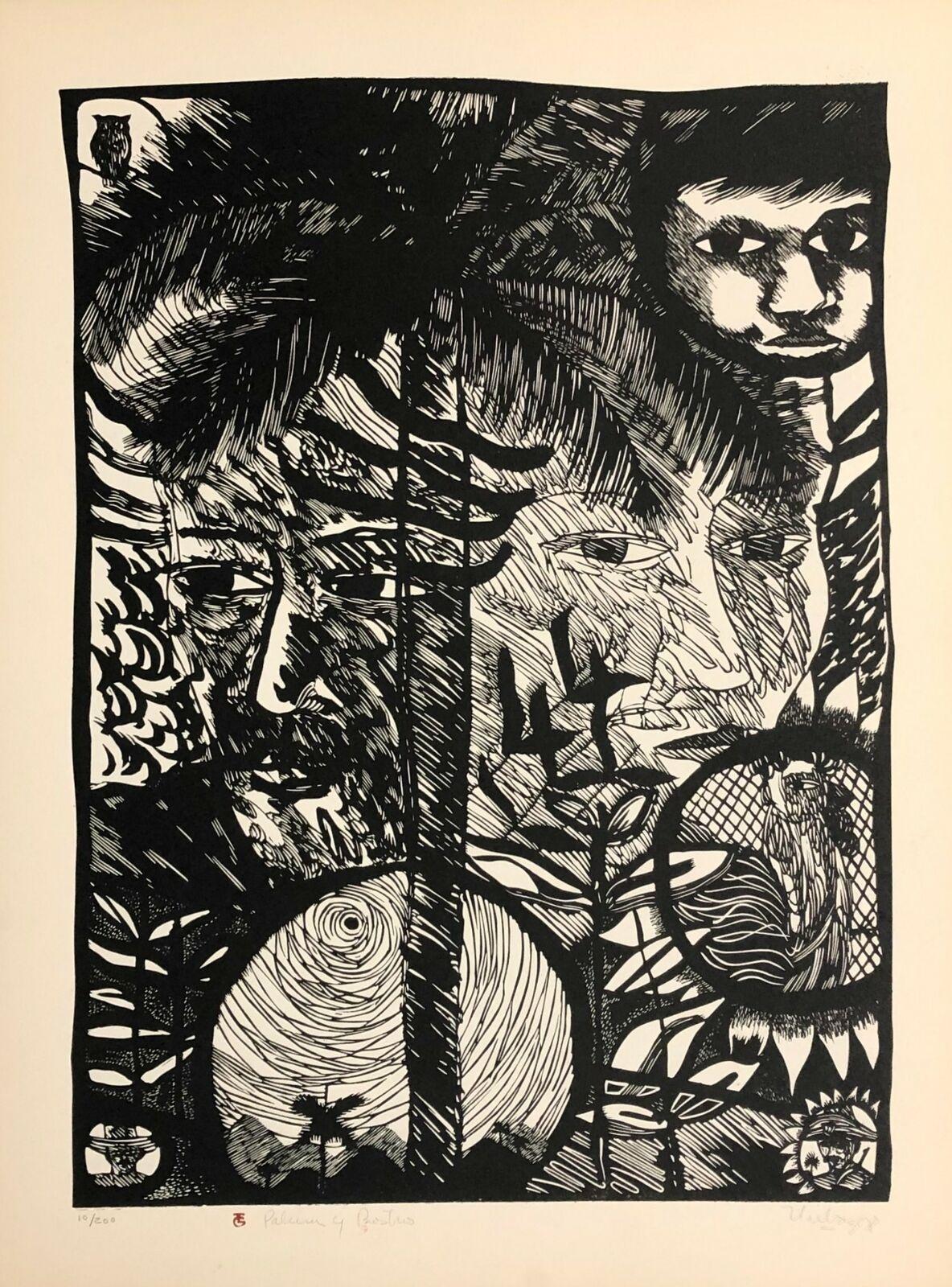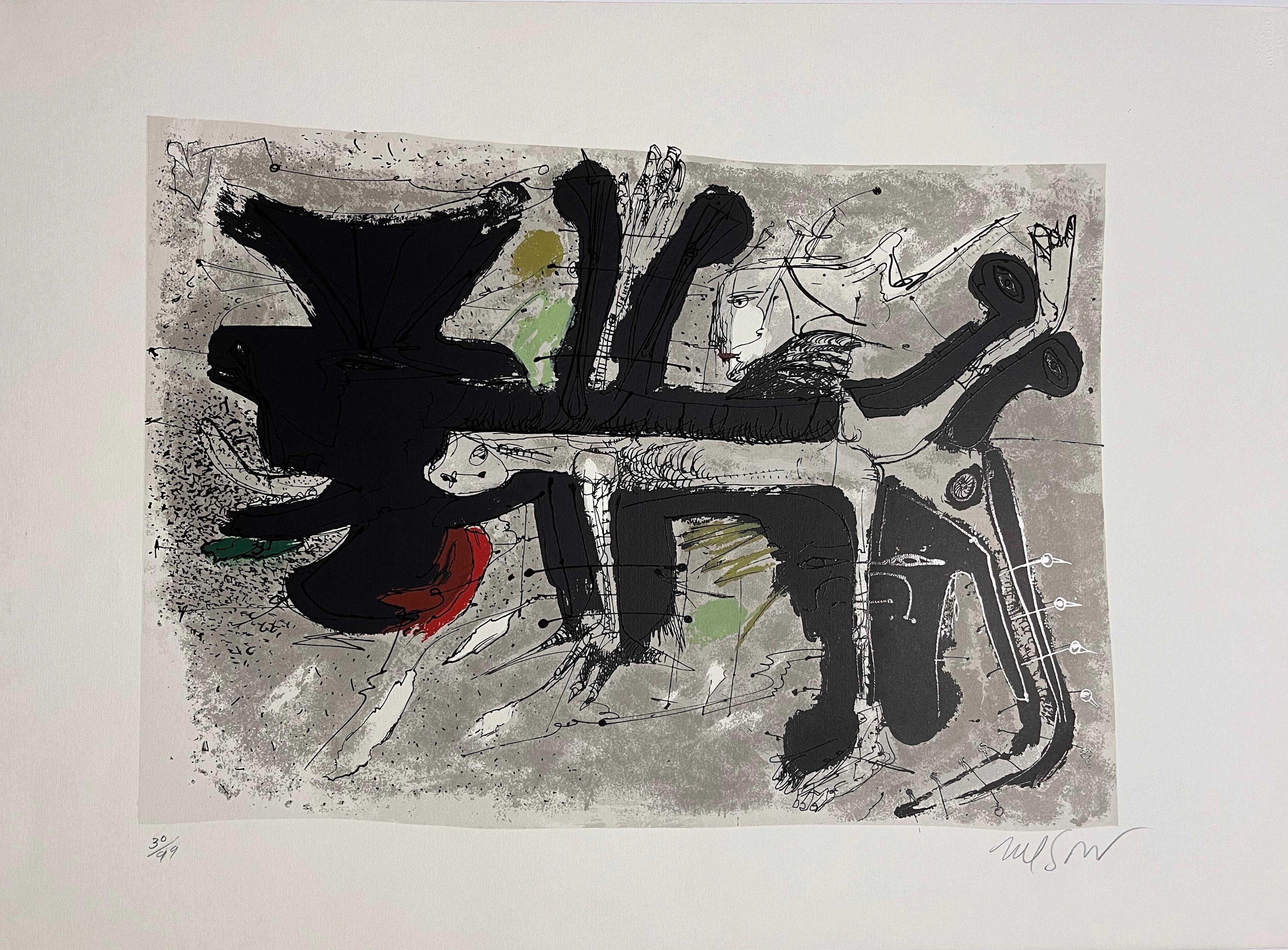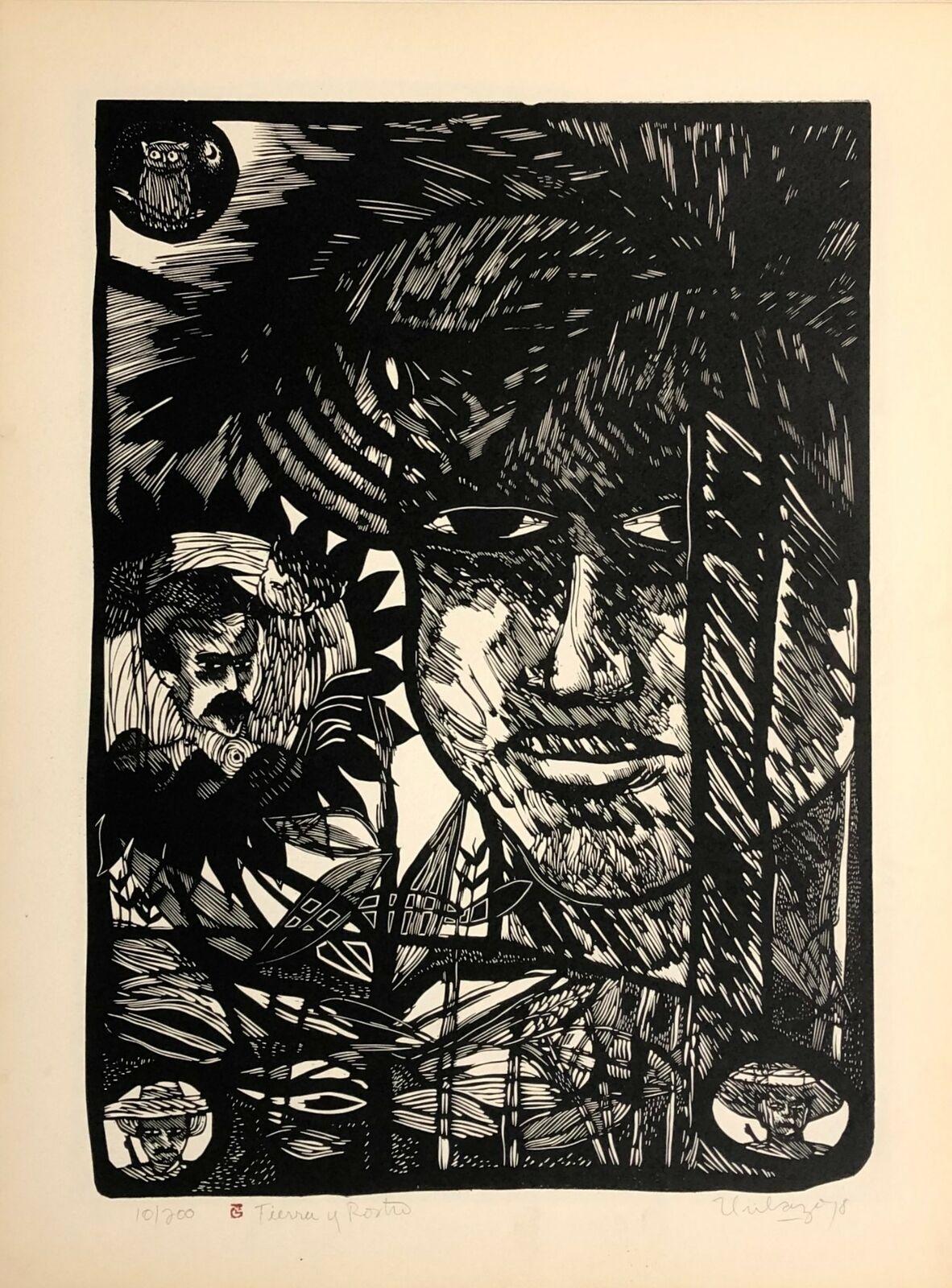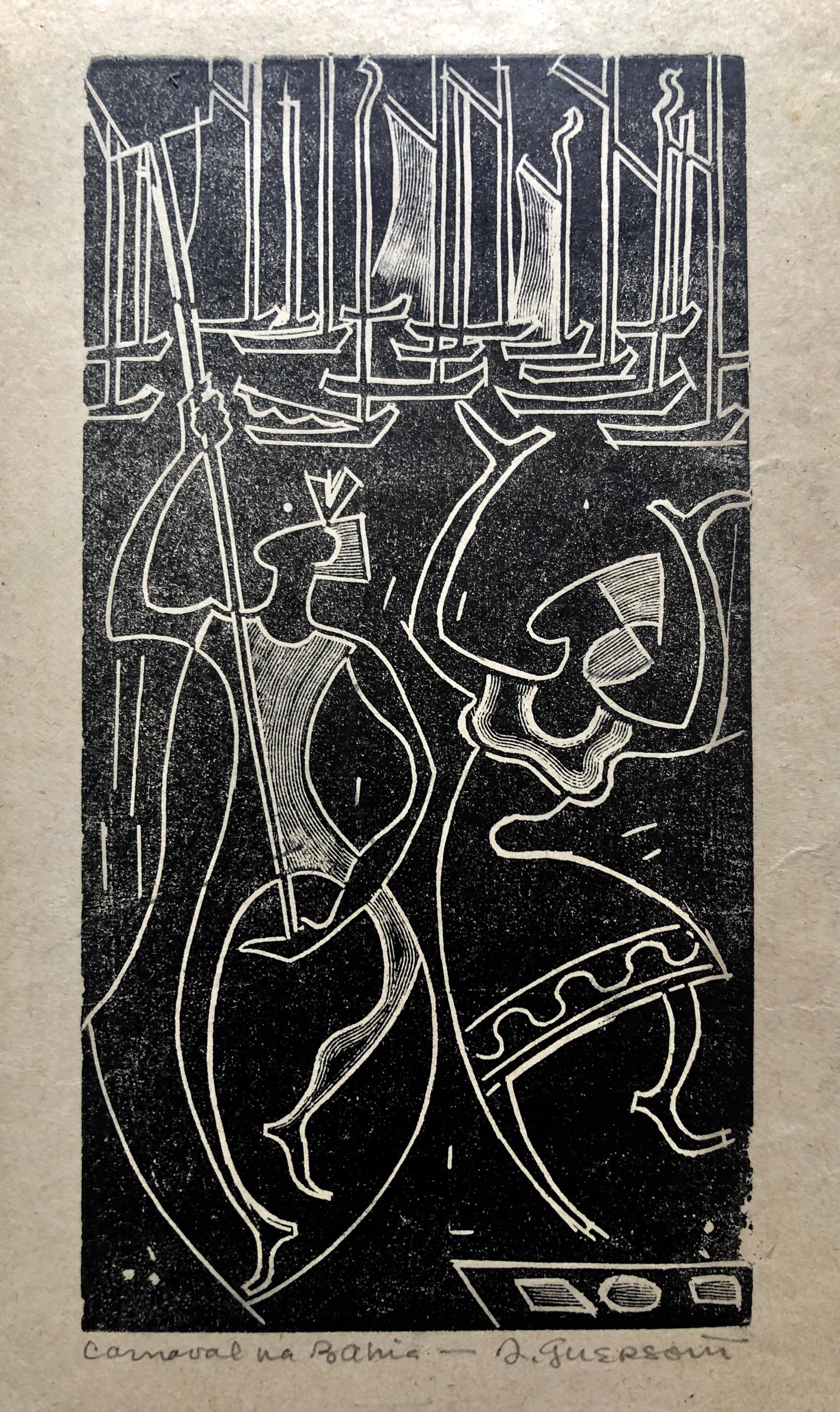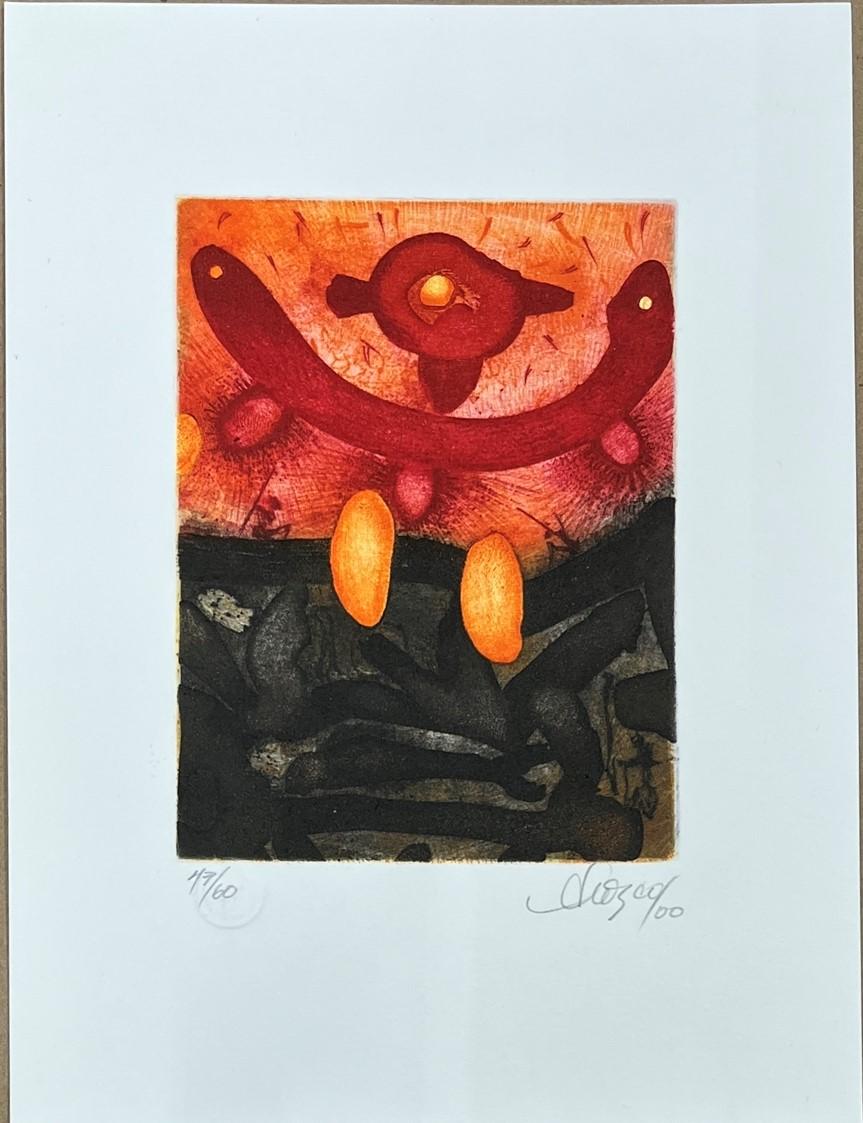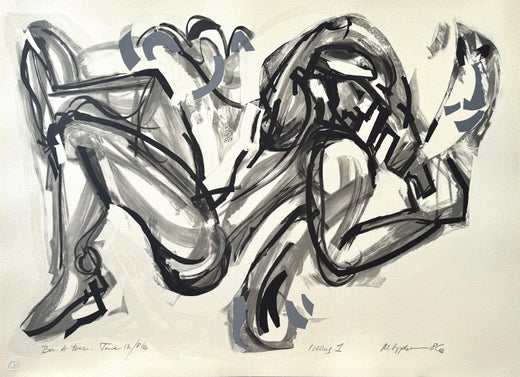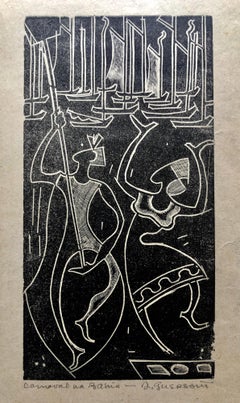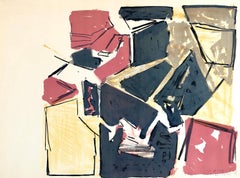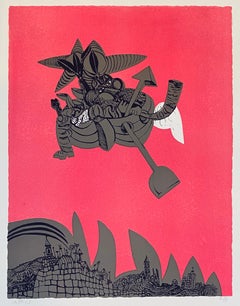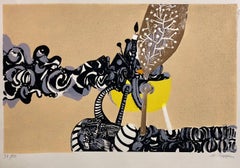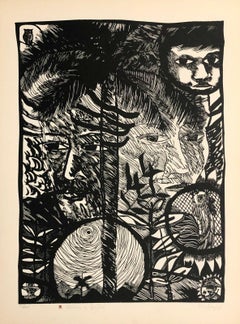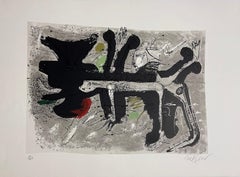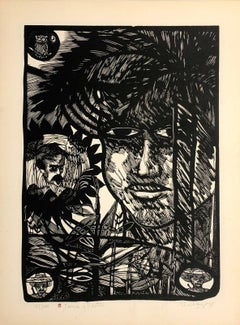Items Similar to Large Venezuelan Modernist Lithograph "The Balcony #3" Color Print
Want more images or videos?
Request additional images or videos from the seller
1 of 10
Marius SznajdermanLarge Venezuelan Modernist Lithograph "The Balcony #3" Color Print1984
1984
$850
£658.81
€745.93
CA$1,216.70
A$1,326.70
CHF 689.55
MX$15,882.40
NOK 8,746.30
SEK 8,192.54
DKK 5,571.17
About the Item
Marius Sznajderman was a painter, printmaker and scenic designer living and working in the United States.
Born in Paris, France in 1926 his Jewish parents had migrated to France from Poland in 1923. In November 1942 the family fled Nazi-occupied France for Spain before settling in Caracas, Venezuela. He attended the School of Fine Arts in Caracas where his teachers included illustrator Ramon Martin Durban, scenic designer Charles Ventrillon-Horber and painter Rafael Monasterios. and immigrated to the United States in 1949, where he received a Bachelor of Fine Arts and Master of Fine Arts from Columbia University in New York. He settled in Hackensack, New Jersey, where he lived and had a studio for more than 50 years before moving to Amherst, Massachusetts in 2015. His work, which includes painting, prints and collages, as well as set designs, is in more than 45 museum and public institution collections in the United States, Latin America and Israel. He held more than 40 solo exhibitions at galleries and museums and participated in more than 75 group shows around the globe.
He helped found the Taller Libre de Arte, an experimental workshop for the visual arts, sponsored by the Ministry of Education. The Taller Libre de Arte was a center for young artists to work and to meet with critics and intellectuals to discuss avant-garde ideas and artistic trends from Europe and Latin America. Among the notable artists who participated in the Taller Libre de Arte were Ramón Vásquez Brito, Carlos González Bogen, Luis Guevara Moreno, Mateo Manaure, Virgilio Trómpiz, Alirio Oramas, Dora Hersen, Alejandro Otero, Jesús Rafael Soto, Pascual Navarro, Aimée Battistini, José Fernández Díaz, Narciso Debourg, Oswaldo Vigas and Perán Erminy.
Sznajderman’s early works as a student and young artist showed the influence of Cubism and Expressionism with subject matter ranging from figures to still life to Venezuelan landscapes. His work often explored Latin American themes, art and architecture.
In 1948 Sznajderman was awarded the art student’s prize for a watercolor in the annual National Gallery exhibit. In 1949 Sznajderman had a solo exhibition at the Taller Libre de Arte. The exhibit catalogue was written by Sergio Antillano, a prominent Venezuelan writer and critic.
That same year, Sznajderman immigrated to the United States to attend Columbia University, where he studied with scenic designer J. Woodman Thompson and printmaker Hans Alexander Mueller. He received a Bachelor of Science degree with a major in scenic design in 1953, after which he was drafted into the U.S. Army. In the military he worked as an artist-illustrator, completing his service in 1955. He returned to Columbia on the G.I Bill to attend Teachers College, where he received a Master of Fine Arts in art education.
During the 1950s Sznajderman created set designs for Circle in the Square Theatre, the French Art Theatre and the Felix Fibish Dance Company, all in New York. By the late 1950s, however, his focus was shifting to fine arts and teaching.
In 1960 Sznajderman was among the three founders, along with painters Sam Weinik and Ben Wilson, of the Modern Artists Guild (MAG), an association of modern artists working in northern New Jersey. Among the artists who were early members of MAG were Esther Rosen, Alexandra Merker, Erna Weill, Jerry Goldman, Lillian Marzell and Evelyn Wilson.
In the 1950s, 1960s and 1970s, in addition to painting and printmaking, Sznajderman taught art, art history and design at a number of institutions including New York University, the School of Visual Arts, Fairleigh Dickinson University and the Ridgewood (N.J.) School of Art. He also taught art in New Jersey public schools under federal and state grants. During this period, Sznajderman’s work ranged from drawings, woodcuts and lithographs to watercolor and acrylic paintings and collages. He produced still life, figures, landscapes and seascapes. Inspirations included Venezuelan remembrances, culture and folklore; Mexican art and pre-Columbian imagery; as well as architecture and theater. Other works have been inspired by Greek mythology and the Commedia dell’arte. Contemporary events, such as the Vietnam War and the assassination of the Rev. Martin Luther King, Jr., also inspired some works.
From 1974 to 1983 Sznajderman served as director of Galeria Venezuela in New York City for the National Council of Culture and Fine Arts of Venezuela (CONAC) while continuing to paint and exhibit. From 1980 to 1986 he oversaw the selection and coordination of the international editions of prints for AGPA (Actualidad Grafica – Panamericana), a project of the Latin American Container Corporation of America (later Smurfit Carton de Venezuela).
Throughout his career, Sznajderman has also explored Jewish themes, including works in remembrance of the Holocaust. In 1988 he produced a limited-edition print, in collaboration with his uncle, the Yiddish journalist and author S.L. Shneiderman, on the occasion of Shneiderman’s 80th birthday. The print featured a 1938 poem by Shneiderman, “Elegy for My Shtetl,” written in Yiddish. The Yiddish text for the print was typeset using the last linotype machine used to print the New York-based Yiddish newspaper, The Forward. In 1989 he designed and supervised the production of a Holocaust memorial monument for Temple Beth El in Hackensack, New Jersey. Other works have explored Nazi concentration and extermination camps, the Vichy government and the Holocaust in France.
For many years Sznajderman had a deep friendship and intimate creative relationship with Venezuelan painter Oswaldo Vigas. In 1987, following a trip of the two families to the Venezuelan Andes, a two-person show of landscapes by Sznajderman and Vigas was held at the venerable Ateneo de Caracas, Galeria los Espacios Calidos.
In 1991 the Contemporary Art Museum of Caracas produced a retrospective exhibit of Sznajderman’s work.
In 2001 Sznajderman began a collages and collage constructions series using Yiddish as a leitmotif. A selection of the works were exhibited at the Yiddish Book Center, Amherst, Massachusetts in 2005-2006.
In 2005, Venezuelan poet Hugo Brett Figueroa published the book "Scargot" with illustrations by Sznajderman. Sznajderman also illustrated the 1993 book “Who Were the Pre-Columbians?” by Bernard Barken Kaufman and “Magicismos,” a book of poems by the Venezuelan poet Enrique Hernandez D’Jesus, published in 1989.
In 2007, Warsaw Ghetto Revolt mural project and a Nazi concentration camp woodcut series created in 1958 and 1959, was exhibited at the Puffin Cultural Forum in Teaneck, New Jersey.[8] In 2011 and 2012 he produced the “Yanaka” series of collages on paper and a large collage construction using Chiyogami - traditional Japanese printed paper - purchased in 1990 in Tokyo.
In 2011 Sznajderman created seven collages using unauthorized lithographs by Salvador Dali as material. The collages were reproduced in a limited-edition booklet titled “Dali, Dumas and Me.” The booklet described a series of events involving the late painter and printmaker Jorge Dumas, who had printed the Dali lithographs. The booklet was presented in 2013 during a solo exhibit by Sznajderman in New York City at Chashama Exhibit Space.
More recently, Sznajderman created a series of print-collages composed from early serigraphs produced in the 1960s. He continued to work and exhibit until the final weeks of his life.
Permanent Collections and Exhibitions
Sznajderman's work is represented in the permanent collections of more than 45 museums and institutions, primarily in the United States but also in Europe, Latin America and Israel. They include the Smithsonian Institution, the Library of Congress, Instituto Nacional de Bellas Artes y Literatura in Mexico City, Museo de Bellas Artes (Caracas), the Museum of Jewish Heritage in New York, the Cincinnati Art Museum, the Simon Wiesenthal Center, the Birmingham Civil Rights Institute, the Irish Museum of Modern Art in Dublin and Yad Vashem in Jerusalem.
- Creator:Marius Sznajderman (1926 - 2018, American, French)
- Creation Year:1984
- Dimensions:Height: 21.75 in (55.25 cm)Width: 29.75 in (75.57 cm)
- Medium:
- Movement & Style:
- Period:
- Condition:
- Gallery Location:Surfside, FL
- Reference Number:1stDibs: LU38212986482
Marius Sznajderman
Born in Paris in 1926, Marius Sznajderman escaped with his parents from France in November of 1942 and lived in Venezuela until 1949, at which time he moved to the United States. He studied at the Museum of Fine Arts in Caracas and Columbia University. In Caracas, he was a founding member of Taller Libre de Arte. In his 40 years as an artist, he has had numerous one-man shows in the US and South America, and his work is in the permanent collections of many important museums.
About the Seller
4.9
Platinum Seller
Premium sellers with a 4.7+ rating and 24-hour response times
Established in 1995
1stDibs seller since 2014
1,833 sales on 1stDibs
Typical response time: 1 hour
- ShippingRetrieving quote...Shipping from: Surfside, FL
- Return Policy
More From This Seller
View All1945 Brazilian Master, Art Deco Nudes Serigraph Woodcut Carnaval Bahia
By Odetto Guersoni
Located in Surfside, FL
Genre: Brazilian Art Deco, African Diaspora
Bahian Carnival
Subject: Abstract
Medium: Print
Surface: Paper
Country: Brazil
Dimensions of overall paper are listed.
This is from a series of work he did in the 1940's, we sold one called Ritmo Negro, they are about Afro-Brazilian jazz, dance and music.
Odetto Guersoni was born in the city of Jaboticabal, State of São Paulo, in 1924. From 1936 to 1941 he attended the Liceu de Artes de Ofícios in São Paulo, beginning his artistic career in 1945, when he exhibited paintings in the Hall of the Plastic Artists Union . Two years later he was part of the collective group of 19, alongside Aldemir, Charoux, Otavio Araújo, Grassmann, Maria Leontina and several other artists that time would make famous. He then practiced a figurative painting of accentuated Expressionist lauds, characterized by deformation and coloring, raw and Satirical- as, moreover, so many of his fellow exhibitors at the time. As a French government scholar, Odette Guerzoni went to Paris in 1947 and the following year took part in the Peintres et Graveurs Etrangers and Art Libre exhibitions. Student of engraving by Renê Cottet, gradually transformed this expressive medium into his favorite, to the detriment of painting, which he practically abandoned soon after.
In 1947, he participated in the 19 Painters exhibition at the Prestes Maia Gallery together with Lothar Charoux, Maria Leontina,Grassmann, Aldemir Martins, Luiz Sacilotto and hiró. Guersoni was awarded a scholarship by the French government, and traveled to Paris, where he began work in engraving. Back in Brazil, in 1951, he founded the Art Workshop, in São Paulo. In 1954, he returned to Europe for a year, financed by the International Labor Organization (ILO). In Geneva, he studied engraving with René Cottet (1902 - 1992) and worked in Stanley william Hayter's studio, Atelier 17, in Paris (1901 - 1988). From 1956 to 1957, he became director of the Union of Plastic Artists of São Paulo. From 1960, he attended, as a trainee, some art schools in the United States and Japan such as The New York School of Printing and Osaka University. In 1971, also in Japan, he attended the workshop of I. Jokuriti. Two years later, he was voted Best Recorder of the Year by the Paulista Association of Art Critics - APCA. He took part in a special room at the Ibero-American Biennial in Montevideo in 1983. The Pinacoteca do Estado de São Paulo - Pesp presents a retrospective of his work in 1994.
Odetto Guersoni explores the wide spectrum of possibilities of the engraving. In addition to using techniques such as metal etching, lithograph, serigraph, linocut and, especially, woodcut he developed, in the 1950s, the philigraphy, in which the forms he developed gained points of embroidery made by Bonadei (1906 - 1974) . And, in the 1960s, the plastigraphy, in which he makes engravings on pasty surfaces, obtained from gypsum or other soft material. In the 1970s, technical investigations were associated with pictographic, ideographic, archaic symbol searches, Brazilian cave paintings and plant forms. The drawings are reduced to stylized, geometric shapes and transformed into abstract graphic elements. The artist works with few matrices, which, organized in rectangles, squares or circles, become modules to be combined. Guersoni juxtaposes them, adds, changes colors, and thereby composes colorful mandalas and structural geometries. Based on concise compositions, it produces color vibrations through optical illusions. In many of his woodcut works of the 1980s he uses smooth wood, knives, saws, gouges, punches, avoiding the natural textures of wood. In printing, it leaves the vibrant color and employs dosed inks with colorless masses, obtaining transparencies by superpositions. New journeys of study and specialization in engraving techniques took him in 1954 to Switzerland, 1960 to the United States, and in 1966 to Germany and Austria. Today, after having performed more than 40 individuals including 16 abroad and having participated in more than 50 collectives in several countries, Guersoni is considered one of the most notable Brazilian engravers. Conquered awards in several shows.
CHRONOLOGY
Individual exhibitions
1946 - Sao Paulo SP - 10th Salon of the Artists' Union, at the Prestes Maia Gallery
1947 - São Paulo SP - 19 Painters, at the Prestes Maia Gallery
1948 - Paris France - Peintres et Graveurs Etrangers at the École des Beaux-Arts
1949 - São Paulo SP - 13th Salon of the Artists' Union, at the Prestes Maia Gallery
1951 - São Paulo SP - 1st Paulista Salon of Modern Art, at Prestes Maia Gallery - silver medal
1953 - São Paulo SP - 2nd International Biennial of São Paulo, at MAM / SP
1954 - São Paulo SP - 3rd Paulista Salon of Modern Art, in the Prestes Maia Gallery
1955 - Rio de Janeiro RJ - 4th National Salon of Modern Art
1955 - Salvador BA - 5th Baiano Salon of Fine Arts, in Belvedere da Sé - honorable mention
1962 - São Paulo SP - Leirner Prize for Contemporary Art at the Folha Art Gallery - 1st printing award
1963 - Curitiba PR - 20th Salão Paranaense de Belas Artes, at the Public Library of Paraná
1963 - Rio de Janeiro RJ - Individual, no MAM / RJ
1968 - Bradford England - First International Print Biennale
1970 - São Paulo SP - Antonio Henrique Amaral, Odetto Guersoni, Tomie Ohtake, Pedro Tort and Gerda Brentani, in the Alberto Bonfiglioli Gallery
1971 - São Paulo SP - 11th International Biennial of São Paulo, at the Biennial Foundation - acquisition award
1973 - Punta del Este Uruguay - 1st Engraving Meeting of the Prata Basin Countries - International Prize
1977 - São Paulo SP - The Groups: the 40's, at the Lasar Segall Museum
1982 - São Paulo SP - Ismenia Coaracy, Odetto Guersoni and Alice Brill...
Category
1940s Art Deco Nude Prints
Materials
Woodcut
Israeli Josef Zaritsky Abstract Modernist Lithograph Print "Composition"
Located in Surfside, FL
Abstract Composition, 1959 Lithograph
This was from a portfolio which included works by Yosl Bergner, Menashe Kadishman, Yosef Zaritsky, Aharon Kahana, Moshe Tamir and Michael Gross.
Joseph (Yossef) Zaritsky (Hebrew: יוסף זריצקי; September 1, 1891 – November 30, 1985) was one of Israel's greatest artists and one of the early promoters of modern art in the Land of Israel both during the period of the Yishuv (Palestine, the body of Jewish residents in the Land of Israel before the establishment of the State of Israel) and after the establishment of the State. In 1948 Zaritsky was one of the founders of the "Ofakim Hadashim" group. In his works he created a uniquely Israeli style of abstract art, which he sought to promote by means of the group. For this work he was awarded the Israel Prize for painting in 1959.
Joseph Zaritsky...
Category
1950s Modern Abstract Prints
Materials
Lithograph
Israeli Surrealist Judaica Abstract Lithograph Naftali Bezem
By Naftali Bezem
Located in Surfside, FL
Naftali Bezem (Hebrew: נפתלי בזם; born November 27, 1924) is an Israeli painter, muralist, and sculptor.
Bezem was born in Essen, Germany, in 1924. His early adolescence was spent...
Category
20th Century Modern Prints and Multiples
Materials
Lithograph
Rare Israeli Surrealist Judaica Abstract Lithograph Naftali Bezem
By Naftali Bezem
Located in Surfside, FL
Fine lithograph on deckle edged French Arches paper. Pencil signed and numbered from edition of 150.
A Surrealist Judaica scene of a bearded man (Rabbi) in a boat with Shabbat candlesticks. with blindstamp from Editions Empreinte in Paris, France. (They published, Jean Michel Folon, Sempe, Raoul Ubac, Raymond Savignac, Cesar, Bengt Lindstrom , Paul Aizpiri and many other modern masters.
Naftali Bezem (Hebrew: נפתלי בזם; born November 27, 1924) is an Israeli painter, muralist, and sculptor.
Bezem was born in Essen, Germany, in 1924. His early adolescence was spent under Nazi oppression, in constant fear for the safety of his parents, who perished in the Holocaust in the Polish Auschwitz concentration camp. Naftali emigrated to Mandate Palestine in 1939, at the age of fourteen with a Youth Aliyah group.
From 1943 to 1946, he studied art at the Bezalel Academy of Art and Design in Jerusalem with Israeli painter Mordecai Ardon. He then spent three years studying in Paris.His most famous public works include a wall relief at Yad Vashem in Jerusalem and the ceiling mural in the main reception room at the President's Residence, Jerusalem.In 1957, Bezem was a co-recipient of the Dizengoff Prize for Painting.
Group Exhibitions
Orit Art Gallery, Tel Aviv
Artists: Yosef Zaritsky, Marcel Janco, Lea Nikel, Robert Baser, Bezem, Michael Druks,
Israeli Painting (Watercolors and Gouache)
Artists:
Pinchas Abramovich, Bezem, Naftali Nachum Gutman, Haim Gliksberg, Mordechai Levanon, Avigdor Stematsky, Avshalom Okashi, Yehiel Krize...
Category
20th Century Modern Figurative Prints
Materials
Lithograph
Color Embossed Lithograph Print New York Abstract Expressionist Woman Artist
By Amaranth Ehrenhalt
Located in Surfside, FL
This print depicts a non-objective composition of organic shapes rendered in vibrant hues of color upon a field of white.
Hand signed by artist in pencil lower right. Title and numb...
Category
20th Century Abstract Expressionist Abstract Prints
Materials
Color, Lithograph
Israeli Surrealist Judaica Abstract Lithograph Naftali Bezem
By Naftali Bezem
Located in Surfside, FL
Naftali Bezem (Hebrew: נפתלי בזם; born November 27, 1924) is an Israeli painter, muralist, and sculptor.
Bezem was born in Essen, Germany, in 1924. His early adolescence was spent...
Category
20th Century Modern Prints and Multiples
Materials
Lithograph
You May Also Like
Carlos Uribazo Cuban Artist Original Hand Signed silkscreen 1978
Located in Miami, FL
Carlos Uribazo (Cuba, 1951)
'Untitled (from Porfolio Grabados Cubanos)', 1978
silkscreen on paper Canson 320 g.
23.6 x 17.6 in. (59.8 x 44.6 cm.)
Edition of 200
ID: URI-302
Hand-sign...
Category
1970s Contemporary Prints and Multiples
Materials
Paper, Engraving, Screen
Nelson Dominguez Cuban artist original limited edition silkscreen 20x28 in.
Located in Miami, FL
Nelson Dominguez (Cuba, 1947)
'Lagartos', ca. 1995
silkscreen on paper
19.7 x 27.6 in. (50 x 70 cm.)
Edition of 99
ID: DOM1267-002
_______________________________________
Biography. Nelson DOMÍNGUEZ.
Born: 1947, Santiago de Cuba, Cuba.
Studies: 1970 National School of Art, Cuba.
Experience: 1970 - 1985 Professor National School of Art, Cuba. He has been Professor of Painting and Engraving and Head of the Painting Department of the Higher Institute of Art (ISA). Member of the Union of Writers of Cuba and the International Association of Plastic Artists.
Awards: Among the awards and recognitions that the Cuban artist received: Order for the National Culture, Cuba; Order Alejo Carpentier, Cuba; Diploma and Order of Honor from the Fuji Museum, Japan. In 1972, he received the National Prize at the International Painting Festival in Cagnes-sur-mer, France; 1976 Grand Prize, International Biennial of Wood Engraving, Banska Bystrika, Czechoslovakia and Painting Prize, Triennial of Committed Realist Art, Sofia, Bulgaria; Honor Prize, Graphic Biennial, India, as well as at the Jaime Guasch Biennial in Barcelona, Spain.
Exhibitions In summary, exhibitions of personalities. In 1983 he made the exhibition ""Retrospective (10 years of professional work)"" at the National Museum of the Palace of Fine Arts of Cuba, in 1984 at the Francoise Tournie Gallery in Paris; in 1985 he did it in the National Welfare Organization of Athens, Greece and in 1986 in the Gallery del l 'Incisione in Venice, Italy. During the eighties and nineties his work was shown in Brazil, Italy, Puerto Rico, Japan, Mexico, Spain, the United States, Cuba and Mexico. In 2001, an individual exhibition was held at the Hotel Trip Cayo Coco in Cuba.
Collections: Many of his works are exhibited in the Los Oficios Studio Gallery, Old Havana, Cuba and in the collections of the National Museum of Fine Arts of Cuba, Merugo Museum of Japan; Herbeat F. Johnson Museum of Art of the United States; The Presidential House, Los Pinos, of Mexico; Alejo Carpentier Foundation and José Martí Memorial Collection, Havana, Cuba; Collection Imperial Palace of Japan; Center for Cuban Studies in New York; Julio Cortázar...
Category
21st Century and Contemporary Contemporary Figurative Prints
Materials
Paper, Screen
Nelson Dominguez Cuban artist original limited edition silkscreen 20x28 in.
Located in Miami, FL
Nelson Dominguez (Cuba, 1947)
'Lagartos', ca. 1995
silkscreen on paper
19.7 x 27.6 in. (50 x 70 cm.)
Edition of 99
ID: DOM1267-002
Biography. Nelson DOMÍNGUEZ.
Born: 1947, Santiag...
Category
1990s Contemporary Figurative Prints
Materials
Paper, Screen, Cotton, Ink
Carlos Uribazo Cuban Artist Original Hand Signed silkscreen 1978
Located in Miami, FL
Carlos Uribazo (Cuba, 1951)
'Untitled (from Porfolio Grabados Cubanos)', 1978
silkscreen on paper Canson 320 g.
23.6 x 17.6 in. (59.8 x 44.6 cm.)
Edition of 200
ID: URI-301
Hand-sign...
Category
1970s Contemporary Prints and Multiples
Materials
Paper, Engraving, Screen
Raimundo Orozco Cuban Artist Original Hand Signed engraving 2000
Located in Miami, FL
Raimundo Orozco (Cuba, 1949)
'Untitled', 2000
engraving on paper Guarro Biblos 250g.
10.1 x 6.6 in. (25.6 x 16.6 cm.)
Edition of 60
ID: ORO-312-054
Hand-signed by author
Category
Early 2000s Contemporary Prints and Multiples
Materials
Paper, Aquatint, Screen, Engraving
Sao Paulo, Modern Abstract Lithograph by Johnny Friedlaender
By Johnny Friedlaender
Located in Long Island City, NY
Johnny Friedlaender, German (1912 - 1992) - Sao Paulo, Year: circa 1970, Medium: Lithograph on Arches, signed and numbered in pencil, Edition: 275, Image Size: 29 x 18.25 inches, Siz...
Category
1970s Modern Prints and Multiples
Materials
Lithograph
More Ways To Browse
Vintage Dumas
Show Globe
Alejandro Otero
Fernandez Diaz
Original Toulouse Lautrec Lithograph
Peter Sager
Picasso Saltimbanques
Picture Of Dorian Gray
Pierre Casanova
Police Mugshot
Privat Livemont
Rene Portocarrero
Renoir Drawings
Royal Albert Old Country Roses
Salvador Dali 1967
Salvador Dali Mythology
Sem Georges Goursat
Sonia Delaunay Pochoirs
